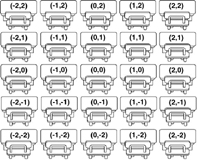|
Human
Coordinate Plane: Student Worksheet

Name: ____________________________________

Arrange 25 desks in a square
array and have students sit in them. Explain that they are a human
coordinate plane and each of them is to receive a card with an ordered
pair (x,y) on it. Ask students who are not seated to distribute the
ordered pair cards to the appropriate location. They may need to refer
to a grid with points labeled as shown:
| (-2,2) |
(-1,2) |
(0,2) |
(1,2) |
(2,2) |
| (-2,1) |
(-1,1) |
(0,1) |
(1,1) |
(2,1) |
| (-2,0) |
(-1,0) |
(0,0) |
(1,0) |
(2,0) |
| (-2,-1) |
(-1,-1) |
(0,-1) |
(1,-1) |
(2,-1) |
| (-2,-2) |
(-1,-2) |
(0,-2) |
(1,-2) |
(2,-2) |

Students work individually
and as a class

- 25 large ordered pair
cards labeled as shown above
- large grid with the points
shown above labeled
- overhead projector or
chalkboard

- Ask the student whose ordered pair card has 0 as the first number
to stand. Through discussion identify 0 as the x-coordinate and the
students standing as the y-axis, they should now sit and students
whose ordered card pair has 0 as the second number should stand. Again,
discussion should identify the 0 as the y-coordinate and the students
standing as the x-axis.
- Ask each student with an x-coordinate of 1 to stand up and write
x = 1 on the board. Now ask students with an x-coordinate of -2 to
stand and write x = -2 on the board. Through discussion, lead students
to see that equations of the form shown are:
- a vertical line
- parallel to the y-axis
- Ask each student with a y-coordinate of 1 to stand up and write
y = 1 on the board. Now ask students with a y-coordinate of -1 to
stand and write y = -1 on the board. Through discussion, lead students
to see that equations of the form shown are:
- a horizontal line
- parallel to the x-axis
- Ask the students whose ordered pair has a sum of 1 to stand and
write x + y = 1. These students should remain standing while students
whose ordered pair first number - the second number equals 1 stand.
Write x - y = 1 on the board. Through discussion, lead student to
see that (1,0) is a point on both lines and represents the point of
intersection. Substitute values in the equations on the board to show
that (1,0) makes both x + y = 1 and x - y = 1 true.
- Repeat the above process using x + y = 1 and x + y = 2. Guide students
to discover that if there is no point of intersection, the lines are
parallel.

As a result of this activity,
students will have a better understanding of the coordinate plane.

Ask students whose ordered
pair sum is 2 to raise their hands. Now ask students whose ordered
pair sum in less than 2 to stand and write x + y < 2 on
the board. Show the students a graph with a dotted line for x+ y =
2 and shading for x + y < 2. Note that the shading includes all
points, not just integral values. Repeat the process for other inequalities.
|